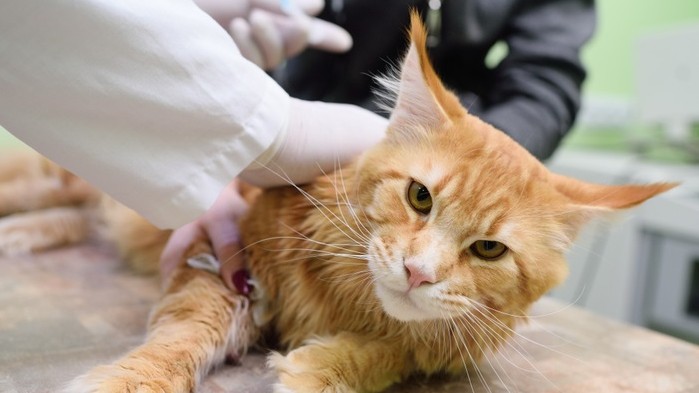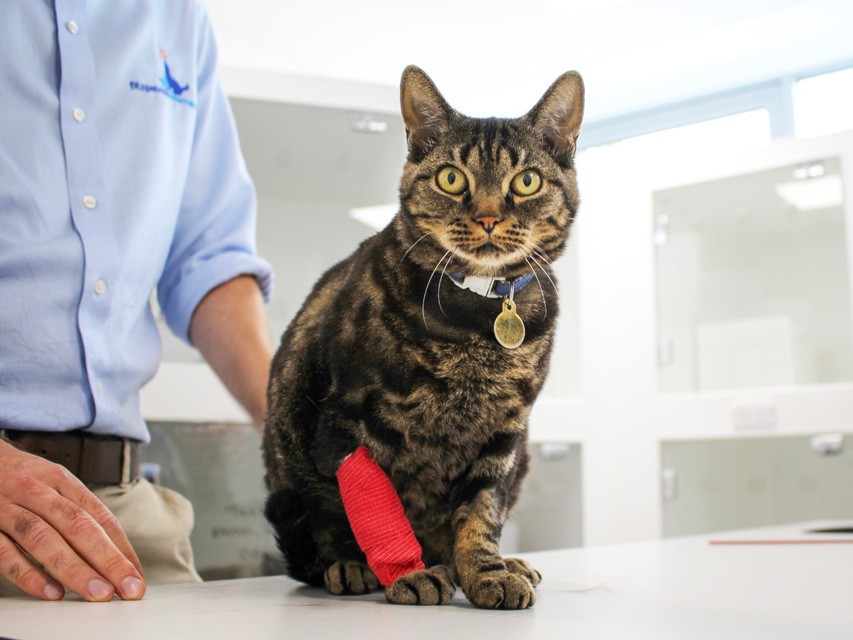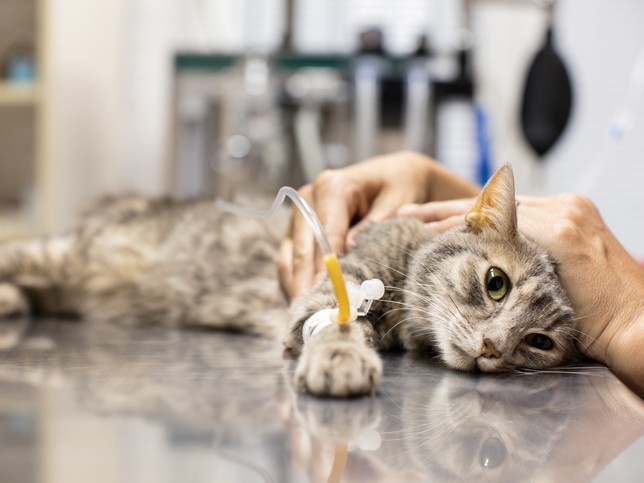Welcome to our guide that unravels the mystery of lymphoma in cats—a journey that invites you to explore the intricate world of feline health. Just like the unique personalities of our furry friends, lymphoma comes in various forms, making it a complex challenge to comprehend.

In this immersive article, we’ll embark on a captivating quest together. We’ll delve into the origins of lymphoma, decipher its telltale signs, and equip you with the tools to understand how it affects our feline companions. With interactive insights into diagnostic approaches, treatment options, and real-life stories, you’ll become an informed advocate for your cat’s well-being.
So, let’s dive in! Click, scroll, and navigate your way through this guide as we demystify lymphoma in cats, one interactive step at a time. Your journey towards feline health empowerment starts now.
What Is Lymphoma?
Lymphoma is a kind of cancer that affects the immune system’s lymphatic system[1] .The lymphatic system is made up of organs, tissues, and veins that generate and transport lymph, a fluid containing white blood cells, throughout the body. By eliminating foreign substances and waste products from the blood, the lymphatic system aids in the battle against infections and illnesses.

Lymphoma develops when some white blood cells, known as lymphocytes, become aberrant and multiply excessively. These aberrant cells can cause tumors in a variety of organs, including the lymph nodes, spleen, liver, bone marrow, intestines, chest, skin, and nervous system.
Lymphoma can affect cats of any age, breed, or gender, but it is more common in older cats and cats that are infected with feline leukemia virus (FeLV) or feline immunodeficiency virus (FIV).
Types Of Lymphoma
Lymphoma is the most frequent feline cancer, accounting for approximately 30% of all feline cancers. Tumors are divided into distinct categories based on their location, appearance, and behavior[2]
The following are some of the most common kinds of lymphoma in cats:
Intestinal lymphoma:
This type of lymphoma affects the gastrointestinal tract and is the most frequent type of lymphoma in cats, accounting for 50-70% of cases. It is most frequent in senior cats, with an average age at diagnosis of 9-13 years.
Weight loss, vomiting, diarrhea, loss of appetite, and stomach pain or swelling are all symptoms. A sample of the intestinal tissue is frequently taken and examined under a microscope to make the diagnosis.
The treatment may include surgery to remove the tumor or chemotherapy to eliminate the cancer cells. The prognosis is determined by the tumor’s grade, which indicates how rapidly it grows and spreads. Low-grade cancers develop slowly and are less aggressive, whereas high-grade tumors grow quickly and are more invasive.
Mediastinal lymphoma:
This form, which involves the chest cavity, is frequently associated with FeLV or FIV infections. It is more frequent in young cats, with the average age at diagnosis ranging between 2-4 years.
Breathing difficulties, coughing, wheezing, and fluid collection in the chest are all signs. An X-ray or CT scan of the chest is commonly used to make the diagnosis, which looks for a lump or enlarged lymph nodes.
Multicentric lymphoma:
This type of lymphoma affects various organs and tissues throughout the body and is also linked to FeLV or FIV infections. Cats of any age can be affected, however, it is more common in middle-aged to older cats.
Depending on the organs affected, the symptoms may include lymph node swelling, fever, tiredness, weight loss, anemia, or organ failure. A biopsy of the afflicted organ or tissue is usually taken and examined under a microscope to make the diagnosis.
Chemotherapy may be used to destroy cancer cells, or supportive care may be used to control symptoms. Most cats die within a few weeks to months of being diagnosed, therefore, the prognosis is bleak.
What Causes Lymphoma in Cats?
Although the actual etiology of lymphoma in cats is unknown, there are some risk factors that may raise the likelihood of developing the condition[3].Some of these elements are:
Cats infected with FeLV or FIV have a higher risk of acquiring lymphoma than cats that are not infected.
FeLV and FIV are retroviruses that can cause cancer by damaging the DNA of infected cells. FeLV can also depress the immune system, making it more difficult for the body to fight infections and diseases.
Genetic predisposition:
Some cat breeds are more likely than others to acquire lymphoma. Siamese cats, for example, have been observed to have a greater prevalence of mediastinal lymphoma than other breeds.
How Can Lymphoma Be Prevented in Cats?
There is no proven way to avoid lymphoma in cats, but there are several precautions you may do to lower your cat’s risk. Among these steps are[4]:
Vaccinate your cat against FeLV:
FeLV vaccine can prevent your cat from infection and minimize the risk of lymphoma development. However, vaccination does not ensure protection; thus, you should keep your cat indoors and away from other diseased cats. You should also test your cat for FeLV and FIV before and after vaccination.
Spay or neuter your cat:
Spaying or neutering your cat can reduce the risk of developing lymphoma by eliminating the hormonal influence on the growth of the lymphatic tissue. It can also help to prevent unintended births and slow the spread of FeLV and FIV.

Feed your cat a balanced and nutritious food:
Feeding your cat a high-quality, nutritionally complete meal can help enhance its immune system and avoid infections and diseases. You should also avoid giving raw or undercooked meat to your cat since it may contain bacteria or parasites that cause illness or cancer.
Keep your cat away from harmful substances:
Keeping your cat away from substances that may be toxic or carcinogenic can help prevent lymphoma and other health problems.
You should not smoke in front of your cat or expose it to secondhand smoke. You should also avoid applying pesticides or herbicides in your garden or home, and instead choose pet-safe alternatives. You should also keep any chemicals or drugs in a secure location that your cat cannot get.
How to Treat Lymphoma in Cats?
If your cat has lymphoma, consult with your veterinarian about the best treatment choices for your cat.
The type, stage, and grade of the lymphoma, as well as your cat’s overall health and condition, will determine the treatment. Some of the therapeutic options include:
Chemotherapy
It is the use of chemicals to either kill or inhibit the growth of cancer cells. It is the most commonly used treatment for lymphoma in cats since it can target numerous areas of the disease and enhance cats’ survival and quality of life.

However, chemotherapy can cause nausea, vomiting, diarrhea, hair loss, low blood cell counts, and increased vulnerability.
Your veterinarian will evaluate your cat’s response to the medication and change the dosage and frequency as needed. You must also exercise caution while handling your cat or its waste during chemotherapy, since some of the medications may be secreted in the urine or feces and constitute a risk to you or other animals.
Surgery:
Surgery is the removal of the tumor or part of the affected organ or tissue. When the tumor is localized and accessible, such as in the intestine or skin, it may be utilized to treat lymphoma in cats.
However, surgery alone is rarely curative for lymphoma in cats since it does not address the disease’s systemic nature.
As a result, surgery is frequently combined with chemotherapy or other treatments to improve outcomes.
Radiation therapy:
Radiation therapy is the use of high-energy rays that damage the DNA of the cancer cells and stop them from growing. When the tumor is localized and inaccessible, such as in the nasal cavity or brain, it may be utilized to treat lymphoma in cats.
Radiation therapy, on the other hand, can cause skin irritation, hair loss, eye impairment, and nerve damage. The dose and frequency of medication will be determined by your veterinarian based on your cat’s condition and tolerance.
You should also use caution while touching your cat following radiation therapy, as some of the rays may linger in its body for some time and constitute a harm to you or other animals.
Immunotherapy:
Immunotherapy is the use of substances that stimulate or enhance the immune system’s ability to fight cancer cells. It may be used to treat lymphoma in cats when other treatments are not effective or cause too many side effects.
Some examples of immunotherapy are monoclonal antibodies , cytokines , or vaccines . However, immunotherapy is still experimental and not widely available for lymphoma in cats. It may also have some side effects, such as allergic reactions, inflammation, or infection.
FAQs
1. How common is lymphoma in cats?
Lymphoma is one of the most prevalent forms of cancer in cats, accounting for a significant portion of feline cancer cases. Its occurrence can vary depending on factors such as age, breed, and overall health.
2. What are the typical signs of lymphoma in cats?
Lymphoma’s symptoms can be diverse, ranging from weight loss, lethargy, and loss of appetite to enlarged lymph nodes and gastrointestinal issues. It’s essential to recognize these signs early and seek veterinary care promptly.
3. How is feline lymphoma diagnosed?
Diagnosis often involves a combination of physical examinations, blood tests, biopsies, imaging, and sometimes, fluid analysis. Your veterinarian will work closely with you to determine the most appropriate diagnostic approach.
4. Can lymphoma in cats be treated?
Yes, lymphoma is treatable, and treatment options can include chemotherapy, radiation therapy, and in some cases, surgery. The approach will depend on factors such as the type of lymphoma and your cat’s overall health.
5. How can I support my cat during lymphoma treatment?
Providing a comfortable and stress-free environment is crucial. Regular veterinary visits, adhering to treatment plans, and ensuring proper nutrition are essential steps. Additionally, shower your cat with love, attention, and patience.
6. Are there preventive measures against feline lymphoma?
While there’s no guaranteed prevention, maintaining your cat’s overall health through proper nutrition, regular exercise, and routine veterinary care can contribute to their well-being and potentially reduce the risk of certain health issues, including lymphoma.
Conclusion
In navigating the intricate landscape of feline lymphoma, we’ve gained vital insights into its nature and impact. Equipped with knowledge about its signs, diagnostic avenues, and treatment possibilities, you’re empowered to be a proactive advocate for your feline companion’s health.
By staying vigilant, seeking professional guidance, and offering unwavering care, you play a pivotal role in enhancing the quality of life for your beloved cat. As you continue this journey, remember that every step you take in understanding and addressing lymphoma contributes to a brighter and healthier future for your furry friend.
References:
- Kwak, D., Cho, M., Park, H., Song, K., & Seo, K. W. (2021). A retrospective study of 16 cats with intermediate- to high-grade alimentary lymphoma. Korean Journal of Veterinary Research, 61(1), e8. Lymphoma-Cat
- Lymphoma in cats | VCA Animal Hospitals. (n.d.). Vca. Types-of-lymphoma-in-cats
- Boldan, M., DVM. (2022). Lymphoma in cats. PetMD.
- Lymphoma. (2021, June 17). Cornell University College of Veterinary Medicine. lymphoma-prevention

